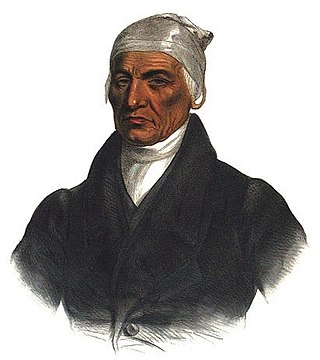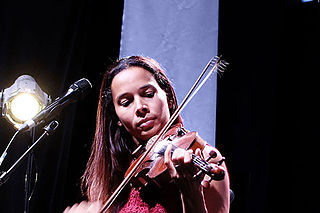
The Tongva are an Indigenous people of California from the Los Angeles Basin and the Southern Channel Islands, an area covering approximately 4,000 square miles (10,000 km2). In the precolonial era, the people lived in as many as 100 villages and primarily identified by their village rather than by a pan-tribal name. During colonization, the Spanish referred to these people as Gabrieleño and Fernandeño, names derived from the Spanish missions built on their land: Mission San Gabriel Arcángel and Mission San Fernando Rey de España. Tongva is the most widely circulated endonym among the people, used by Narcisa Higuera in 1905 to refer to inhabitants in the vicinity of Mission San Gabriel. Some people who identify as direct lineal descendants of the people advocate the use of their ancestral name Kizh as an endonym.

The Fort Mohave Indian Reservation is an Indian reservation along the Colorado River, currently encompassing 23,669 acres (95.79 km2) in Arizona, 12,633 acres (51.12 km2) in California, and 5,582 acres (22.59 km2) in Nevada. The reservation is home to approximately 1,100 members of the federally recognized Fort Mojave Indian Tribe of Arizona, California, and Nevada, a federally recognized tribe of Mohave people.

Serrano is a language in the Serran branch of the Uto-Aztecan family spoken by the Serrano people of Southern California. The language is closely related to Tongva, Tataviam, Kitanemuk and Vanyume. Serrano has free word order with the only rule being that verbs usually come last.

The Institute of American Indian Arts (IAIA) is a public tribal land-grant college in Santa Fe, New Mexico, United States. The college focuses on Native American art. It operates the Museum of Contemporary Native Arts (MoCNA), which is housed in the historic Santa Fe Federal Building, a landmark Pueblo Revival building listed on the National Register of Historic Places as Federal Building. The museum houses the National Collection of Contemporary Indian Art, with more than 7,000 items.
Mohave or Mojave is the native language of the Mohave people along the Colorado River in northwestern Arizona, southeastern California, and southwestern Nevada. Approximately 70% of the speakers reside in Arizona, while approximately 30% reside in California. It belongs to the River branch of the Yuman language family, together with Quechan and Maricopa.

Mekoche was the name of one of the five divisions of the Shawnee Nation, a Native American people, during the 18th century. The other four divisions were the Chalahgawtha, Kispoko, Pekowi, and Hathawekela. Together these divisions formed the loose confederacy that is the Shawnee Nation.
The Nemaha Half-Breed Reservation was established by the Fourth Treaty of Prairie du Chien of 1830, which set aside a tract of land for the mixed-ancestry descendants of French-Canadian trappers and women of the Oto, Iowa, and Omaha, as well as the Yankton and Santee Sioux tribes.

The Iowa Reservation of the Iowa Tribe of Kansas and Nebraska straddles the borders of southeast Richardson County in southeastern Nebraska and Brown and Doniphan counties in northeastern Kansas. Tribal headquarters are west of White Cloud, Kansas. The reservation was defined in a treaty from March 1861. As of 2023, the tribe operates Casino White Cloud on the reservation.

Amethyst Amelia Kelly, known professionally as Iggy Azalea, is an Australian rapper, songwriter, and model. Born in Sydney, Australia, Azalea moved to the United States at the age of 16 in order to pursue a career in music. Azalea earned public recognition after releasing the music videos for her songs "Pussy" and "Two Times" on YouTube. Shortly after releasing those two songs, she released her debut mixtape, Ignorant Art (2011), and subsequently signed a recording contract with American rapper T.I.'s Grand Hustle label.

Rhiannon Giddens is an American musician known for her eclectic folk music. She is a founding member of the country, blues, and old-time music band the Carolina Chocolate Drops, where she was the lead singer, fiddle player, and banjo player.

Lorin Morgan-Richards is an American author, illustrator, and songwriter, primarily known for his young adult fiction and Gothic Western comedy series The Goodbye Family.
Trocon Markous Robert Jr., better known by his stage name FKi 1st, $1T or 1st Down, is an American rapper, singer, songwriter, DJ, and record producer. He first became known as one half of the Atlanta-based production duo FKi with fellow producer SauceLordRich, which was formed in 2007. The duo produced for music industry artists in hip hop and contemporary R&B during the 2010s, resulting in credits on Billboard Hot 100-charting singles such as "Dope" by Tyga, "Watch Out" by 2 Chainz, "Make It Rain", "Bring It Back" and "Ayy Ladies" by Travis Porter, as well as the quadruple platinum-certified single "Weekend" by Mac Miller. In his solo work, Robert has co-produced the singles "Work" for Iggy Azalea in 2013, "White Iverson" for Post Malone in 2015, co-wrote "Deja Vu" for the artist the following year, and "Pick It Up" for Famous Dex in 2017.

Talkhouse is a digital media outlet and online magazine created in 2013 by Ian Wheeler and Tim Putnam. Musicians, actors, and filmmakers share their experiences in their respective fields in personal essays, discuss their peers’ work in editorials and reviews, and converse with one another via the Talkhouse Podcast and Talkhouse Live events.

Dominga Sotomayor Castillo is a Chilean filmmaker.
Kizh Kit’c are the Mission Indians of San Gabriel, according to Andrew Salas, Smithsonian Institution, Congress, the Catholic Church, the San Gabriel Mission, and other Indigenous communities.
Joe "Peps" Galarza is a Chicano artist, educator, and musician based in Los Angeles. He is the bassist for the Chicano rap group Aztlan Underground.
Mercedes Dorame is an American photographer based in Malibu, California.












